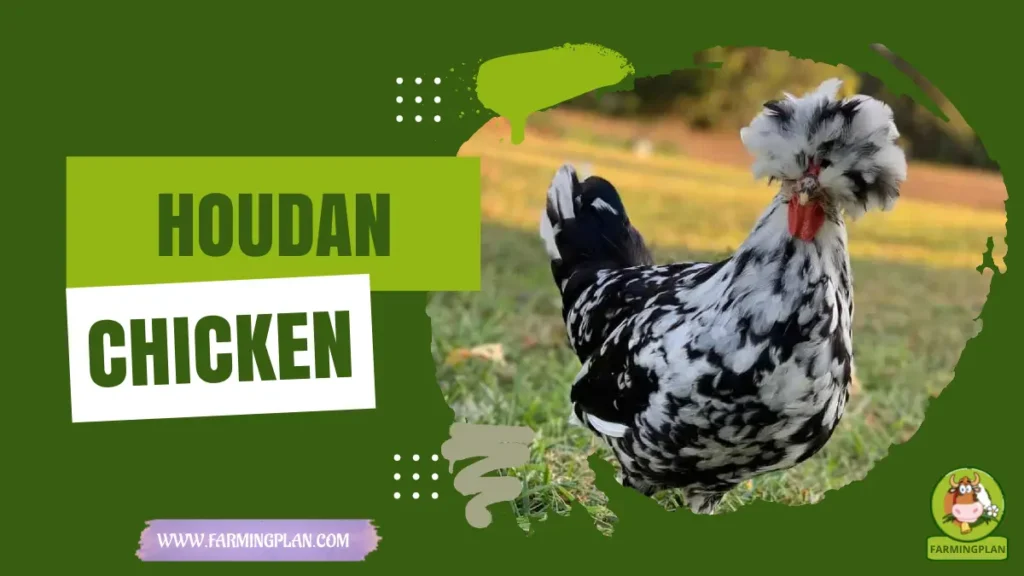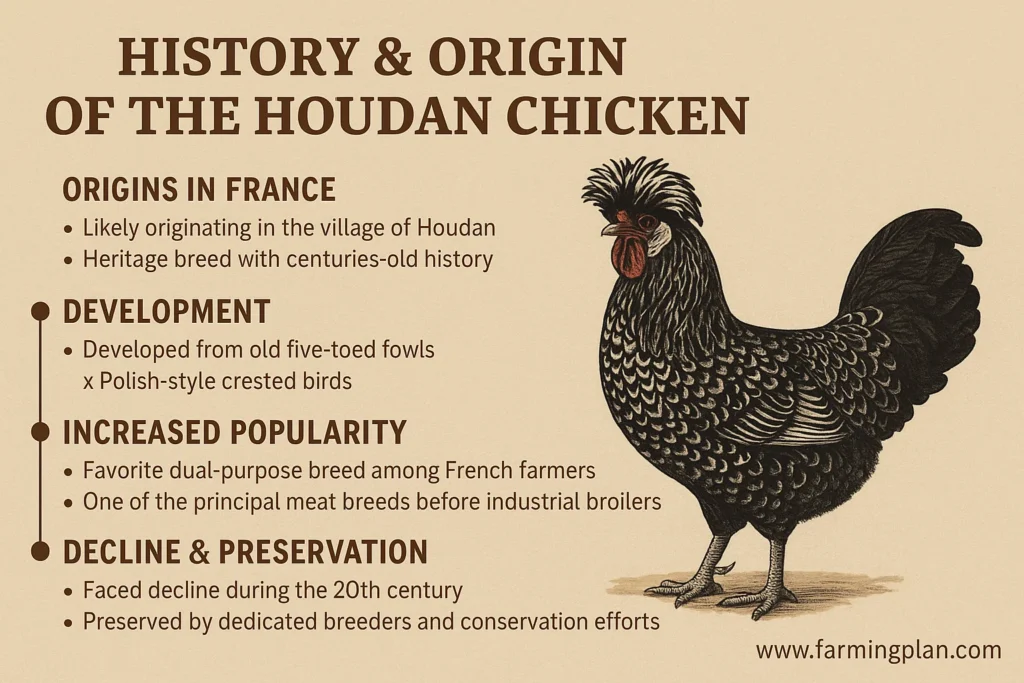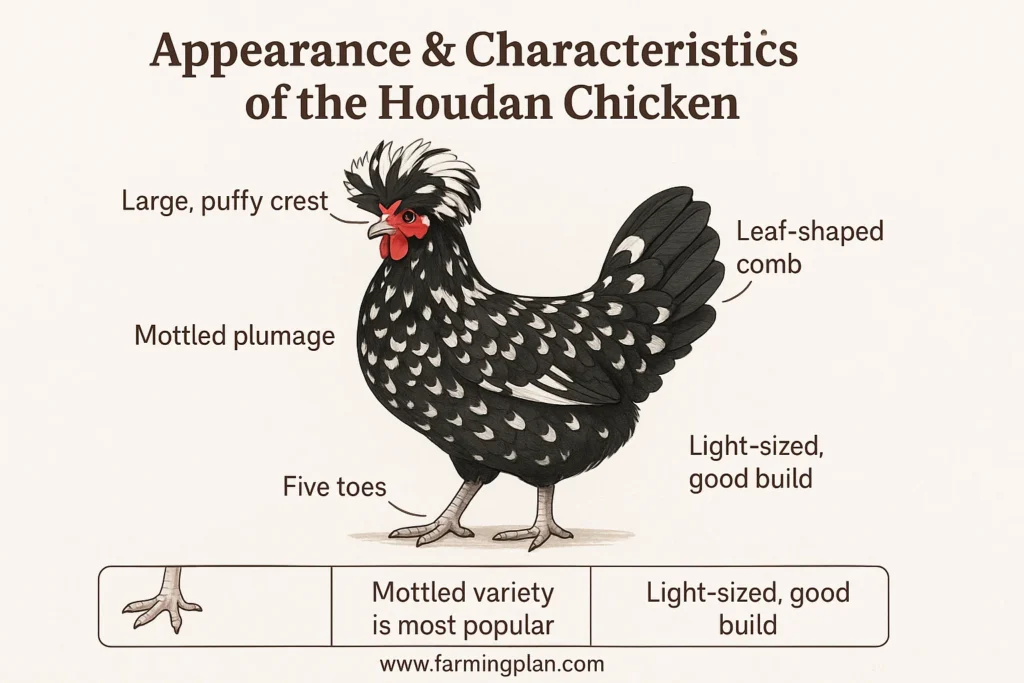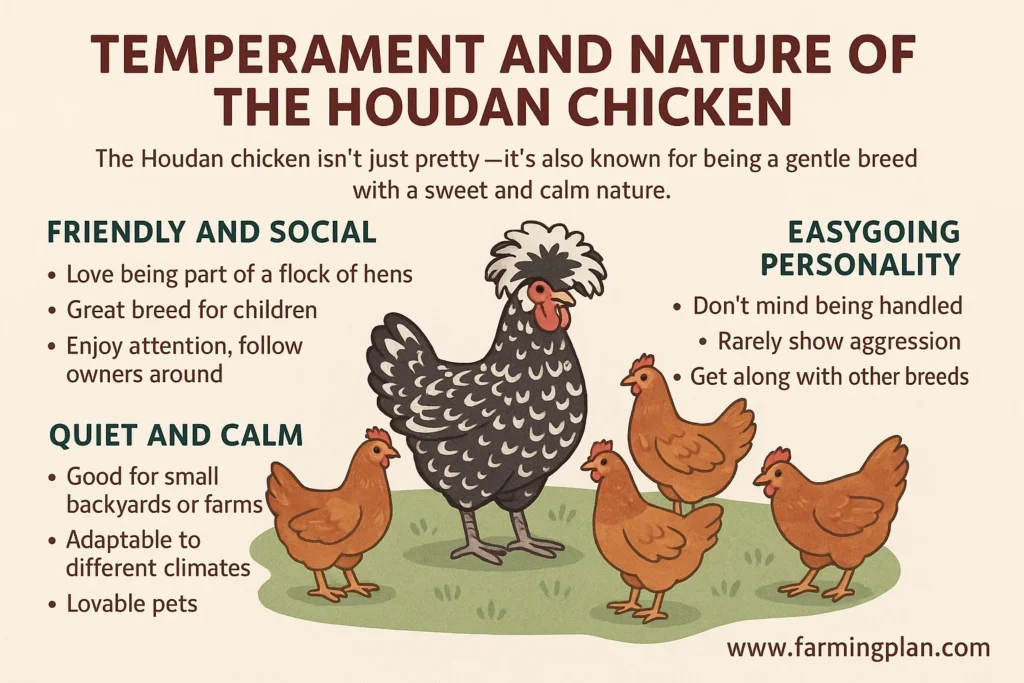The Houdan Chicken with the puffy crest, its special V-shaped comb and friendly temperament, is a breed that attracts the attention with its uniqueness and excites the interest. This French bird, which stands-out between the ranks of ornamental and dual-purpose fowl, provides an excellent combination of form and function. Its quiet nature, its history, its beauty – it really is a heritage treasure. Let’s take a look as to what makes this adorable breed so charming.

History & Origin of the Houdan Chicken
The Houdan Chicken, with its rich and fascinating history that dates back several centuries, is a breed deeply rooted in heritage. This French breed, likely originating in the village of Houdan, has been part of French farming culture since at least the nineteenth century, making it one of the oldest heritage breeds in Europe.

Originally developed from old five-toed fowls crossed with Polish-style crested birds, the Houdan became a favorite among French farmers for its dual-purpose value. It gained popularity as one of the principal meat breeds before the rise of industrial broilers. By the mid-1800s, the Houdan had reached England and eventually made its way to the United States, where it was admired for its attractive appearance and productive traits.
Despite facing a decline during the 20th century, the breed remains preserved thanks to dedicated breeders and heritage breed conservation efforts. Today, Houdans are treasured as a rare but valuable part of poultry history—ideal for homesteads, small farms, and breeding projects focused on historic and ornamental fowl.
Read More: Plymouth Rock Chicken: Friendly & Farm-Ready
Appearance & Characteristics of the Houdan Chicken
The Houdan Chicken, known for its stunning appearance and rare features, is one of the most ornamental breeds in the poultry world. Its large, puffy crest of feathers gives it a fun, almost cartoonish look, making it a standout among ornamental breeds.

Another standout feature is their unusual leaf-shaped comb, often described as a v-shaped comb, which sets them apart from most other chicken breeds. Houdans also belong to the small group of common five-toed fowls, unlike the usual four-toed chickens. When it comes to color, the most popular variety is the Mottled Houdan, which displays beautiful black-and-white white spotting across its feathers. Other varieties include the White Houdan and a smaller Bantam variety Houdan, both admired for their attractive appearance and calm nature.
Houdans are considered light-sized birds, yet they have a good build for a dual-purpose fowl. Roosters and hens have an upright stance, clean legs, and a refined look that appeals to both breeders and poultry show judges. Whether you’re raising mottled houdan hens, roosters, or houdan chicks, you’ll find that this breed brings elegance and personality to any flock.
Read More: Malay Game Chicken: A Unique Breed
Temperament and Nature of the Houdan Chicken
The Houdan Chicken isn’t just pretty—it’s also known for being a gentle breed with a sweet and calm nature. These birds are friendly, social, and love being part of a flock of hens. Their kind temperament makes them a great breed for children, especially those new to raising chickens.

Houdans enjoy attention and often follow their owners around the yard, making them ideal for homestead birds and family farms. They don’t mind being handled and rarely show aggression, even among roosters. This easygoing personality helps them get along well with other breeds in mixed flocks. Because of their quiet and calm nature, Houdans don’t cause much trouble. They do well in small backyards or larger farm spaces, and they are known for their adaptability to different climates. Their gentle attitude and love for interaction make them not just practical birds but also lovable pets.
Read More: Sebright Chicken: The Beautiful and Friendly Bantam Breed
Feeding & Diet Plan for Houdans
To keep your Houdan Chicken healthy and productive, a proper diet is key. These birds are a dual-purpose breed, so they need a balanced feed that supports both egg laying and meat development. Start your houdan chicks on a high-protein chick starter (about 20% protein) for the first six to eight weeks.
As they grow, switch to a layer feed or grower feed depending on your goals. For hens, a layer pellet with added calcium helps maintain strong eggshells. For meat birds, a feed with slightly higher protein can help them fill out while staying healthy. Houdans enjoy foraging, so letting them free-range gives them access to bugs and greens, which improves their nutrition and behavior. You can also offer treats like corn, veggies, or mealworms—but keep those limited to about 10% of their diet.
Avoid feeding them raw beans, chocolate, salty snacks, or moldy food, as these can be toxic. Always provide clean, fresh water—especially in hot or cold weather.Houdans are considered practical farm birds, and with the right nutrition, they become a truly productive breed that thrives in both backyard setups and small farms.
Uses & Purpose of the Houdan Chicken
The Houdan Chicken is a true dual-purpose bird, valued for both its tasty meat and reliable egg-laying. In the past, Houdans were among France’s popular table birds, prized for their fine-textured meat and well-rounded bodies. Even today, they’re still considered a principal meat breed among heritage breeds. Their eggs are also highly valued, with hens laying around 150-200 medium-sized white eggs per year, making them a productive breed for families and hobby farms. Hens lay around 150–200 medium-sized white eggs per year, making them a productive breed for families and hobby farms. They may not be top egg producers like hybrids, but they offer steady laying and strong health over time.
Thanks to their charming looks and exuberant crest, Houdans also make great ornamental fowl. Many poultry lovers keep Mottled Houdans for shows or as fancy project birds for 4-H and farm schools. Their calm, people-friendly personality adds to their appeal as a practical farm bird or even a pet. If you’re looking for a bird that offers beauty, personality, and usefulness, the Houdan Chicken checks all the boxes.
Special Features That Make Houdans Stand Out
The Houdan Chicken is full of rare and eye-catching traits that set it apart from other breeds. Its most famous feature is the large, puffy crest that gives the bird a regal, almost cartoon-like look. This crest isn’t just fun to look at—it’s part of what makes Houdans a standout among ornamental breeds.
Another unique trait is their leaf-shaped comb, which looks like a “V” or butterfly from above. Most chickens have single or pea combs, but Houdans proudly show off their unusual leaf-shaped combs, making them a favorite at poultry shows. Unlike most chickens that have four toes, Houdans have five. This rare trait places them among the common five-toed fowls, a select group of historic breeds.
Their mottled coloring—especially in the Mottled Houdan hen and rooster—creates a striking blend of black feathers with white spotting. This gives the bird an almost speckled look that’s both elegant and fun. Houdans also tolerate cold weather fairly well, thanks to their full plumage. They’re one of the more adaptable light breeds, thriving in a variety of climates when given proper care.
If your Houdan’s crest gets wet, gently dry it to prevent chilling—especially in cold weather!
Health Issues & How to Prevent Them
While the Houdan Chicken is generally hardy, it does have a few health considerations to keep in mind, especially because of its unique features like the exuberant crest and five toes. Keeping them healthy requires a bit of attention to detail, but with the right care, they thrive.
Common Health Issues
Wet crest: One of the main concerns for Houdans is their large crest. If it gets wet—especially in rainy or cold weather—it can lead to respiratory issues or cold stress. Be sure to keep your Houdans in a dry, well-ventilated coop.
Toe problems: As common five-toed fowls, Houdans can be prone to toe injuries or bursitis from getting caught in the wire or rough surfaces. Regular foot checks and soft bedding help prevent this.
Crest maintenance: The crest can also collect dirt, lice, or mites, which can affect the bird’s health. Regular grooming and cleaning of the feathers are important.
Preventive Care Tips
Proper shelter: Keep Houdans in a dry, well-ventilated coop to protect their crest from becoming damp. Use wood shavings or straw for bedding to avoid moisture buildup.
Regular health checks: Check the birds regularly for signs of illness, like lethargy, watery eyes, or unusual breathing. Also, inspect their toes and crests for any signs of injury or parasites.
Nutrition: A well-balanced diet helps maintain overall health, supporting their immune system and feather growth. Provide fresh water at all times to prevent dehydration, especially during colder months.
Step-by-Step Farming Guide/Pet Owner Care Guide for Houdan Chickens
It is rewarding dealing with Houdan Chickens, due to their calm temper and beauty. Either as pets, for ornamental reasons or for dual purposes, here is a complete guide on how to rear them successfully.
Setting Up the Coop
Size: Houdans are light-sized birds, so they don’t require as much space as larger breeds, but they still need enough room to move comfortably. Aim for at least 2–3 square feet per bird inside the coop, with a safe outdoor run to forage.
Ventilation & Protection: Ensure the coop is well-ventilated to prevent humidity buildup, but also secure enough to keep predators out. Houdans are not particularly flighty, so ensure the fencing is high enough to deter them from flying out.
Bedding: Use clean straw or wood shavings as bedding. Regularly replace bedding to maintain a clean environment and avoid the growth of mold or bacteria.
Feeding Your Houdan
Chick Starter Feed: Begin feeding Houdan chicks a protein-rich starter feed (about 20% protein) for the first 6–8 weeks.
Grower/Layer Feed: Once they reach maturity, switch to a layer feed (16–18% protein) for hens to support egg-laying, or a grower feed for meat purposes.
Free-Range & Treats: Allow your Houdans to forage if possible, as it helps with natural behavior and adds variety to their diet. Supplement with treats like mealworms, leafy greens, and cracked corn.
Daily Care
Water: Provide fresh, clean water at all times. Change the water daily to prevent bacteria buildup.
Feeding Schedule: Feed them twice a day, with one larger feeding in the morning and a smaller one in the evening.
Checking Health: Perform a quick health check every few days, inspecting the feet, feathers, and combs for any signs of injury or illness.
Handling and Socialization
Calm Interactions: Because of their friendly breed traits, Houdans are easy to handle. Spend some time each day interacting with them to maintain their calm nature.
Flock Integration: Houdans are typically peaceful birds that get along well in mixed flocks. However, if introducing new birds, make the transition gradual to prevent stress.
Grooming and Maintenance
Crest Care: Houdans have an exuberant crest that requires regular attention. Keep it dry and clean to prevent dirt or lice buildup. If needed, trim the feathers around the face to improve vision.
Toe Care: Check their feet for any injuries or deformities regularly, particularly because of their five toes.
Winter Care
Houdans tolerate cold weather fairly well, but ensure they have access to a warm, dry shelter during the colder months. Use heat lamps sparingly and ensure the coop is draft-free to avoid chilling.
Expert Tips & Best Practices for Raising Houdan Chickens
Raising Houdan Chickens can be a breeze with the right knowledge. Here are some expert tips and best practices to help ensure your birds thrive, whether you’re new to raising chickens or an experienced farmer:
Maintain Proper Grooming
As mentioned, Houdans’ exuberant crests can be prone to getting wet or dirty, which can lead to health issues. Regular grooming is key! Use a soft brush to clean their feathers, especially around the face and comb. Keeping their crests dry and tidy will help prevent respiratory issues and maintain their charming look.
Avoid Overcrowding
Houdans are friendly birds but still need personal space. Make sure your coop is large enough to accommodate the size of your flock, ideally with room for at least 2–3 square feet per bird inside the coop and more space in the run. Overcrowding can lead to stress, feather-picking, and aggressive behavior.
Introduce New Birds Slowly
If you’re adding Houdan chicks or new adults to your flock, do so slowly to avoid conflicts. Set up separate areas where they can see each other but not interact directly until they get used to the new setup. This helps reduce stress and territorial behavior.
Encourage Foraging
Houdan hens and roosters enjoy foraging, so allow them to free-range when possible. This not only improves their diet but also keeps them mentally stimulated and active. Just be sure they have a safe, enclosed area to roam, protecting them from predators.
Handle with Care
Because of their gentle breed nature, Houdans are easy to handle. However, handle them gently to avoid stressing them out. Frequent socialization from a young age makes them more comfortable with humans, helping them to stay calm and friendly in the long term.
Keep an Eye on Their Health
Regularly monitor your Houdans for signs of illness, especially during the cold weather months when they may be more susceptible to respiratory issues. Keep their coop clean and dry to prevent parasites like mites and lice, which can thrive in damp environments.
Where to Buy Houdan Chickens
If you’re looking to add Houdan chickens to your farm or homestead, there are several reliable sources where you can find these rare and beautiful birds. Whether you’re after houdan chicks, mottled houdan hens, or adult houdan roosters, you can find them through various outlets:
Specialty Hatcheries
Many hatcheries specialize in heritage breeds and rare poultry, including Houdans. Some well-known breeders offer various color varieties like White Houdans and Mottled Houdans, as well as Bantam Houdans for those interested in smaller birds. Look for reputable breeders who focus on maintaining the historical integrity of the breed and follow good breeding practices.
Local Poultry Shows
Attending a poultry show can be a great opportunity to connect with breeders who specialize in Houdans. Many poultry enthusiasts bring their fancy birds to these events, where you can meet the breeders and see the birds in person before making a purchase.
Online Poultry Marketplaces
Websites like eBay, Craigslist, or specialized poultry auction sites are great platforms where you might find Houdan chickens for sale. Be sure to check the breeder’s reviews and ensure they follow humane and responsible breeding practices.
Farmers’ Markets and Local Farms
If you’re in a farming area, check out local farmers’ markets or small farms that specialize in heritage breed poultry. You might find a nearby source offering healthy, well-bred Houdans.
Breed Conservation Groups
Many groups dedicated to the conservation of heritage breeds might have connections to breeders who are selling Houdans. These groups can be an excellent resource for finding ethically bred birds and for learning about the breed’s conservation status.
Poultry Breeder Directories
Some websites and organizations provide directories of poultry breeders, which can be filtered by breed. This allows you to find breeders that specialize specifically in Houdans, ensuring you get high-quality, healthy birds.
FAQ
What is the origin of the Houdan chicken?
The Houdan chicken is a historic French breed developed in the 1700s in the town of Houdan, near Paris. It was originally bred for both meat and egg production and is known for its distinctive appearance, including a full crest, beard, and five toes on each foot .
Are Houdan chickens good for beginners?
Yes, Houdan chickens are generally friendly and docile, making them suitable for beginners. They are known for their calm temperament and are often described as sweet and cuddly, especially when raised from a young age .
How many eggs do Houdan hens lay?
Houdan hens typically lay between 140 and 160 white eggs per year. While this is moderate compared to some other breeds, their gentle nature and unique appearance make them a favorite among poultry enthusiasts .
What are the common color varieties of Houdan chickens?
The most common color variety of the Houdan chicken is mottled, characterized by black feathers with white spots. Other recognized color varieties include black, pearl-grey, and white .
How long do Houdan chickens live?
Houdan chickens typically live for about 7 to 8 years. With proper care, including protection from extreme weather and regular health checks, they can be a long-lived and charming addition to your flock .
Conclusion
The Houdan chicken is a classic French breed known for its distinctive look and the calm and amiable demeanor. First created in the 1700’s it was well valued for both meat and egg production. To date, it is a popular breed of the poultry aficionados because of its distinct attributes and kind temperament. From novice keeper to experienced one, the Houdan can be a charming accession to your flock being combination of beauty and utility.

